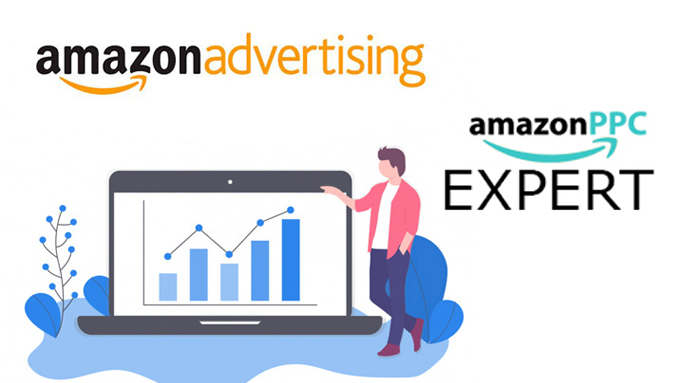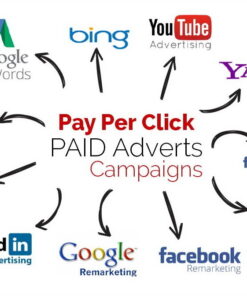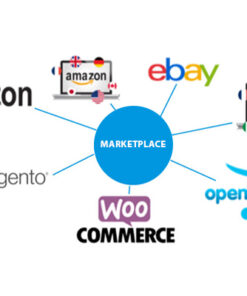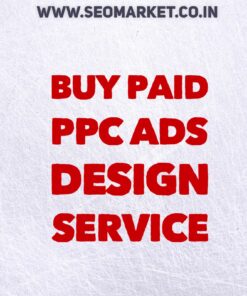Buy Amazon PPC, Amazon sponsored products, Amazon sponsored ads, Amazon campaigns Services
$ 100.00 Original price was: $ 100.00.$ 50.00Current price is: $ 50.00.
What Is Amazon PPC?
Amazon PPC is an advertising model in which advertisers pay a fee to Amazon when a shopper clicks on their ad (pay-per-click). There are 3 Amazon ad types available: Sponsored Products, Sponsored Brands and Sponsored Display Ads. The latter is a new and extended version of the former Product Display ads – PDAs.
Buy Amazon PPC, Amazon sponsored products, Amazon sponsored ads, Amazon campaigns Services
What Is Amazon PPC?
Amazon PPC is an advertising model in which advertisers pay a fee to Amazon when a shopper clicks on their ad (pay-per-click). There are 3 Amazon ad types available: Sponsored Products, Sponsored Brands and Sponsored Display Ads. The latter is a new and extended version of the former Product Display ads – PDAs.
Sponsored Products – keyword- and ASIN-targeted ads similar to Google Adwords, that enable you to promote individual products within Amazon search results and on product detail pages. Sponsored Products are the most popular ads on Amazon.

Sponsored Brands – ads for brand building that allow brands to promote a custom headline, brand logo, and up to 3 products in their ad in the top spot above Amazon search results (and other placements), with the ability to send shoppers to their Amazon Stores page or a custom landing page on Amazon. Newly available are also video ads linking to product detail pages.

Interested to know how many other sellers in your category and marketplace are using Sponsored Brands – and how much revenue they’re making from them?
Use the (free) Sellics Benchmarker [Beta] to find out.
Sponsored Display ads – ads that send shoppers to Amazon product detail pages. They deliver relevant ads both on Amazon and on external websites to shoppers who are visiting or visited (remarketing) specific products on Amazon.

Where do Amazon PPC ads appear?


Sponsored Product ads appear in two locations on Amazon: within search results and on Amazon product detail pages as part of an ad carousel close to the top of the page.
Sponsored Brands ads are displayed in different spots in the Amazon search results page, including the ‘top real estate’ placement above the search results. Sponsored Brands ads can also appear on product detail pages. Read our beginner’s guide to Amazon Sponsored Brands to learn more about using this ad format.
Sponsored Display ads appear below the “Add to Cart” button on Amazon product detail pages, next to and below search results, or on third-party websites and apps depending on the chosen targeting method (product/views targeting).
Who can use Amazon PPC ads?
Both vendors and sellers can use Amazon PPC ads (however sellers need to be enrolled in Amazon Brand Registry, see the table below).
What’s the difference between vendors and sellers? Sellers (sometimes referred to as third-party sellers) sell their products directly to Amazon customers. Vendors (sometimes referred to as first-party sellers) sell their products directly to Amazon in bulk, then Amazon sells them to its customers.
Amazon PPC ads can be used for both FBA and FBM products.
Here’s an overview of all eligibility criteria across the different Amazon ad types:
| ELIGIBILITY CRITERIA | SPONSORED PRODUCTS | SPONSORED BRANDS | SPONSORED DISPLAY |
|---|---|---|---|
| General | Active account in good standing with Amazon | ||
| The ability to ship to the country in which you’re advertising | |||
| Valid payment method | |||
| Seller Type | Professional seller, vendor, Kindle Direct Publishing (KDP) author | Professional seller, vendor, Kindle Direct Publishing (KDP) author | Professional seller, vendor |
| Product | Adult, used, or refurbished products aren’t eligible | Adult, used, or refurbished products aren’t eligible | Adult, used, or refurbished products aren’t eligible |
| Products has to be in stock and in the Buy Box* | Product has to be in stock | ||
| Brand Registry | Sellers must be enrolled in Amazon Brand Registry | Sellers must be enrolled in Amazon Brand Registry | |
| Categories | Eligible categories | Eligible categories | Eligible categories |
Is Amazon PPC Worth It?
Well-run Amazon PPC campaigns help you increase your sales, improve your organic rankings, and build brand awareness. If you’re using Amazon as a selling (but not as an ad) platform, you’re probably missing a huge opportunity.
Why should I try Amazon PPC?
In comparison with other ad channels Amazon PPC is generally very effective because it allows you to reach shoppers where they actually make purchases, i.e. on Amazon.
Amazon PPC allows you to promote your products with highly visible placements on Amazon, with ads appearing on desktop and mobile browsers as well as on Amazon’s app.
With Amazon PPC, you’re able to choose from different Amazon ad types depending on your goals, you can control and flexibly set and scale your budget, and you are easily able to see how your ads have performed with a variety of detailed reports.
Amazon PPC offers a portfolio of different targeting methods from keywords to categories, brands, and products (ASINs—Amazon Standard Identification Numbers) as well as remarketing on external websites to ensure that your message is reaching the desired audience.
What are the Amazon ads pricing / fees?
Sponsored Products, Sponsored Brands, and Sponsored Display ads are purchased on a cost-per-click basis and displayed at no charge – views or impressions are free.
You pay only when a potential customer clicks on the ad. You’re in control of the amount that you’re willing to spend per click and hence the amount you spend on ads.
How does the PPC auction work?
The cost-per-click (CPC) for each ad on Amazon is determined in a so-called second-price auction. Each advertiser submits a default bid (the maximum they are willing to pay per click) for their ad.
The highest bidder wins the highest ad position (ad rank #1) and will also pay the highest CPC, but the highest bidder does not pay the amount they bid. The highest bidder pays only $0.01 more than the second-highest bid.
In the above example, Advertiser 3 wins the auction with a bid of $4.00. If their ad is clicked, the cost of the click charged to Advertiser 3 will be $3.51. This logic also applies for all following ad ranks, e.g. Advertiser 1 (ad rank #2) pays $3.11.
What is the average cost per click (CPC)?
On Amazon.com, the CPCs typically range from $0.02- $3, but your average CPC can vary greatly depending on the product category, marketplace, as well as the ad type. See CPC benchmarks below or in our free Sellics Amazon PPC Benchmarker [Beta].
Are there any hidden fees associated with Amazon PPC?
The short answer is: no. The pricing structure here is transparent and straightforward. You only pay for your Amazon ads only when someone clicks on one of them; and because you set your bids and daily PPC budget, you have total control over how much you spend.
As mentioned above, the exact amount that you pay per click will be determined by the second-highest bidder in the ad auction. If you are the highest bidder you will win the auction and pay $0.01 more than the second-highest bid.
Does Amazon PPC improve organic rankings for my FBA and FBM products?
Yes, it can. Unlike in Google Adwords, Amazon PPC sales have a direct influence on a product’s organic ranking on Amazon. Therefore, more sales generated via Amazon PPC ads will have a positive effect on the organic ranking of your FBA or FBM product.
This effect is especially important for new products. New products generally lack a sales history, and therefore performance data, which in turn negatively affects organic ranking. Amazon PPC can change that by driving traffic to your FBA or FBM product listing and thereby boosting sales as well as generating reviews to drive further conversions.
The Basics of Amazon PPC (Things to Know Before You Start)
In order to run successful Amazon PPC ads, you need to familiarize yourself with the basic building blocks of Amazon PPC. Below we’ve summarized the key concepts and terminology sellers should know when starting out with Amazon Sponsored Ads:
Important building blocks of Amazon PPC (basic terminology)
| AREA | EXPLANATION |
|---|---|
| Targeting | When you set up your Amazon PPC campaign, you can choose to target your ads based on keywords, product ASINs, categories on Amazon as well as remarketing on external websites to audiences that viewed certain products on Amazon (targeting options depend on the ad type). |
| Search terms vs. Targets (e.g. Keywords) | ‘Search terms’ refers to any search query the customer types into the Amazon search field, or – for product page placements – the ASIN the ad appeared on. ‘Targets’ refer to what you bid on in your ad campaigns, e.g. specific keywords, ASINs or categories. Depending on the match type used, a target (e.g. a keyword) can cover multiple search terms. |
| Keyword Match Types | Keyword Match Types determine the degree of match between the keyword and customer search term in order for an ad to appear on Amazon. There are 3 match types available (Broad, Phrase, Exact), all with varying degrees of ad targeting precision & management effort required. |
| Negative Targeting | Negative targets are used to help sellers exclude unwanted search terms from their PPC campaigns. When utilized effectively, negative targeting can be a very powerful tool to help you control your Amazon PPC costs. Negative targets can be both negative keywords (excluding impressions for certain searches) and negative ASINs (excluding impressions on certain product pages). |
| Campaign types | There are automatic and manual campaigns. The main difference is that a manual campaign will give you more accurate results. In an automatic campaign, you let Amazon run your ads for you, and your ad will be automatically matched to all the search terms Amazon deems relevant to your product. In a manual campaign, you choose the targets you wish your ad to be displayed for, giving you greater ad targeting precision. |
| Dynamic Bidding | You can choose to set fixed bids or use Amazon’s dynamic bidding options (‘bid down’, bid ‘up and down’), which allows Amazon to adjust your bids in real time based on the conversion probability. |
| Adjust Bids by Placement | Feel free to use this feature to modify bids to target Top of Search and Product Detail Pages. A bid modifier from 0% to 900% can be applied for targeted placements. |
Be the first to review “Buy Amazon PPC, Amazon sponsored products, Amazon sponsored ads, Amazon campaigns Services”
You must be logged in to post a review.







Reviews
There are no reviews yet.